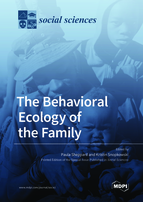The Behavioral Ecology of the Family
A special issue of Social Sciences (ISSN 2076-0760). This special issue belongs to the section "Family Studies".
Deadline for manuscript submissions: closed (15 April 2021) | Viewed by 61693
Special Issue Editors
Interests: reproductive decision-making; fathers; grandparents; life history flexibility; family demography
Special Issue Information
Dear Colleague,
Humans are striking in their extensive and varied typology of family types, including diverse marriage, mating, and descent systems, extended and blended family units, with an array of putative and blood-related “others” that help to raise children. The variety of environments that humans inhabit, both ecologically and socio-culturally, generates different conditions within which families are formed, creating the extensive diversity of human families exhibited across the world.
We are calling for papers that showcase how different ecologies—social, environmental, and cultural—produce variation in family types, formations, and kinship systems more generally. We welcome commentary papers as well as empirical studies using quantitative, qualitative, or mixed methods. We are seeking contributions from researchers working in everything from small-scale societies to large industrialized populations. Our aim is to tell a story of the human family that illustrates how diverse ecologies create the rich varieties of human social systems seen across the globe.
Please submit your proposals and any questions to special issue guest editors by 1 December 2020. Notification of acceptance will be provided by 21 December 2020. Final papers are due on 1 April 2021 for peer review.
Proposals should be one page in length and include a title, an abstract explaining its relevance to the Special Issue topic, a description of the population, and the methods used (if applicable). Also include author names and affiliations.
Dr. Paula Sheppard
Dr. Kristin Snopkowski
Guest Editors
Keywords
- human behavioral ecology
- kinship
- marriage systems
- cross-cultural variation
- cooperation and conflict
- family formation
- cooperative breeding







